THC Instruction Guide
THC Instruction Guide OMB.docx
Teaching Health Center Graduate Medical Education (THCGME) Program Cost Evaluation
THC Instruction Guide
OMB: 0906-0057
Instruction Guide for Teaching Health Center Graduate Medical Education Costing Instrument
Table of Contents
Clinic Patient Visits (Visits) 5
Continuity Clinic(s) Patient Revenue (Revenue) 7
Faculty Salary and Benefits (Faculty Salaries) 10
Residency Program Precepting Agreements (Precepting Agreements) 12
Resident Salaries and Benefits (Resid Salaries) 13
Residency Program Administrative Expenses and In-Kind Donations (Resid Admin) 14
Clinical Administrative Expenses (Clinic Admin) 19
Clinical Operations Expenses (Clinic Ops) 21
Inpatient Revenue and Expenses (IP Revenue and Expenses) 23
Additional Information About Your THC and Continuity Clinic(s) (Additional Info) 25
Public Burden Statement: The purpose of this collection is to determine an appropriate THCGME Program payment for indirect medical expenses (IME) as well as to update, as deemed appropriate, the per resident amount used to determine the Program’s payment for direct medical expenses (DME). An evaluation will be conducted using a standardized THCGME Costing Instrument to gather data from all THCs participating in the THCGME Program. An agency may not conduct or sponsor, and a person is not required to respond to, a collection of information unless it displays a currently valid OMB control number. The OMB control number for this information collection is 0915-XXXX and it is valid until XX/XX/202X. This information collection is required to obtain a benefit as required by Section 5508 of the Affordable Care Act of 2010 amended section 340H of the Public Health Service Act to establish the Teaching Health Center Graduate Medical Education (THCGME) Program in which the Secretary has the authority to determine an appropriate THCGME program payment. Public reporting burden for this collection of information is estimated to average 10 hours per response, including the time for reviewing instructions, searching existing data sources, and completing and reviewing the collection of information. Send comments regarding this burden estimate or any other aspect of this collection of information, including suggestions for reducing this burden, to HRSA Reports Clearance Officer, 5600 Fishers Lane, Room 14N136B, Rockville, Maryland, 20857 or [email protected].
Introduction
The purpose of this Instruction Guide is to help you complete the THCGME Costing Instrument. It provides descriptions of the data fields for each sheet in the THCGME Costing Instrument to serve as a reference while you work through the data submission. For titles with accompanying parentheses, the parentheses indicate the worksheet tab name in the THCGME Costing Instrument.
General Guidance for the THCGME Costing Instrument
Gather materials before you begin: The THCGME Costing Instrument requests detailed information about your THCGME residency program. You will need to gather materials from key personnel such as the CFO, accounting staff, program director, and clinic managers from your THC. Some of the materials needed include: payroll records, general ledger records, and billing information.
Complete this tool for a single THCGME program: Complete separate THCGME Costing Instruments for each THC-accredited program. If expenses are shared between residency programs, report only the proportion of the expenses/revenues attributable to the residency program and its resident continuity clinic(s) that are being reported on.
Decipher the color-coded cells: The THCGME Costing Instrument has been color-coded to guide how you fill out the form. Enter data into the clear (non-colored) cells. If responses require further explanation, enter your notes into the orange cells. Do not enter any data into the gray cells. Gray cells include formulas and will auto-populate based on the data you provide; these cells have been locked to prevent accidental changes.
Data Validation: For validation purposes, GW may request additional information to validate THC expenses and revenues. This additional information will be requested on an ad-hoc basis during the data cleaning phase of the project and may include: general ledgers and trial balances used in the THCGME Costing Instrument, audited financial statements for the periods covering the academic year, source documentation as needed, and supporting schedules to develop a cross-walk between the general ledger and the THCGME Costing Instrument.
Questions? Contact: [email protected].
Basic Information
Name of Residency Program you are providing information on in this Costing Instrument: Enter the ACGME or CODA recognized name of your residency program. For organizations with more than one residency program, write the name of the residency program for which you are reporting in the THCGME Costing Instrument. If your program has a DBA name that differs from the ACGME or CODA recognized name, enter the name as “ACGME/CODA NAME (DBA NAME)”.
THC Program Specialty: This is a drop-down menu. Select the specialty of the THC program for which you are
reporting.
Residency Accreditation: This is a drop-down menu. Select the accreditation body for the residency.
Type of Sponsoring Institution for the Residency Program: This is a drop-down menu. Select the description that best describes the THC’s Sponsoring Institution. If the right category does not appear on the list, select “Other”.
Were you previously accredited by AOA while a THC (Y/N)? Answer yes or no.
Number of continuity clinic(s): Enter the number of resident continuity clinic(s) associated with the residency program for which you are reporting in the THCGME Costing Instrument. If there is one continuity clinic associated with the residency you are reporting data for, enter “1” here. If you are reporting financial information for two continuity clinics associated with your residency program, enter “2” here. For the purposes of the HRSA THCGME cost evaluation, the definition of a continuity clinic aligns with ACGME requirements and has the following definition: A continuity clinic is a setting in which residents develop a continuous, long-term therapeutic relationship with a panel of patients, with the resident serving as the primary physician for this panel.
Number of exam rooms in the continuity clinic(s): Report the total number of exam rooms in the continuity clinic(s). If there is more than one continuity clinic, separately report the number of exam rooms in each of the continuity clinics.
Name(s) of the continuity clinic(s) that you are providing financial information on: Enter the name of the continuity clinic. For example, “Main Street FQHC” may have a clinic called “South Side Clinic” that serves as the continuity clinic. Enter “South Side Clinic” here. If you are reporting financial information for more than one continuity clinic, enter the names of all the continuity clinics for which you are reporting financial information.
Licensure(s) for the continuity clinic(s) that you are providing financial information on: Report the licensure(s) for the continuity clinic(s) listed above.
State(s) in which the continuity clinic(s) are located: Report the state(s) in which the continuity clinic(s) are located.
Reporting Period (most recent academic year): This is an auto-populated cell. The academic period for the THCGME Costing Instrument is July 1st, 2018 – June 30th, 2019.
New or Expansion Program under THC Grant: Indicate whether your THC is best classified as new or expansion. “New” THCs were created with funding from HRSA through the THCGME program. “Expansion” THCs had existing ambulatory-based primary care residency programs prior to the initiation of the THC program.
Accredited Class Size per Year (if expansion, include THC and non-THC residents): Enter the number of residents accredited by ACGME or CODA to train in each THC residency program PGY training year. For example, if the THC program trains 8 residents per year over a 3-year training period, the response would be 8/8/8. In this example, if 2 of the resident slots per year were funded by HRSA through THCGME and 6 of the resident slots were funded by Medicare GME funds passed through by a hospital partner, the correct response would be 8/8/8.
Contact Person: Enter the name of the person who will be the primary contact for follow-up questions or other communications.
Contact Person's E-mail: Enter the primary contact person’s preferred email.
Contact Person's Telephone: Enter the primary contact person’s preferred telephone number.
Signatory: The THCGME Costing Instrument must be reviewed and approved by THC program leadership (e.g., Program Director) prior to its submission to George Washington University. Enter the name and title of the person who approved this submission.
Clinic Patient Visits (Visits)
Page Guidance:
The purpose of this worksheet is to report the total number of visits at the continuity clinic(s) and the distribution of those visits according to whether they are precepted or non-precepted. This distribution will serve as the basis for apportioning clinic expenses and patient service revenues associated with the THC program.
In the table below, enter the name and the number of Non-Precepted and Precepted Visits for the reporting period for the continuity clinic(s) identified on the Basic Info worksheet.
Report only for residents that are part of an approved training program. Visits, expenses, or revenues associated with residents who are not part of an approved training program should not be reported in the THCGME Costing Instrument.
If your state Medicaid program does not allow more than one visit per day, report for the billable visit only. Otherwise, report all visits that meet the FQHC visit definition (see below).
The THCGME Cost Evaluation uses the FQHC definition of a visit: A medically necessary medical, dental, or mental health visit, or a qualified preventive health visit. These visits are one-on-one encounters between the patient and clinician during which one or more FQHC services are provided.
Continuity clinic(s) that are located in settings other than FQHCs should also follow this general guidance.
Number of Ambulatory Visits in the Continuity Clinic(s)
Report Non-Precepted Visits in your continuity clinic(s) for Residency Faculty. Residency Faculty are those listed on the Faculty Salaries worksheet (e.g. Program Director, Core Faculty, Part time Faculty, Other Faculty). Non-Precepted Visits by Residency Faculty are conducted as part of the faculty member’s clinical practice and are not part of residency precepting responsibilities.
In the column Residency Faculty Precepted Visits, report the number of visits conducted by Residents per PGY year.
In the column Other Providers, report all Other Non-Teaching Provider Visits. This includes clinicians who conduct visits at the continuity clinic(s). These providers are most commonly advanced practice clinicians such as PAs, NPs, CNMs, or other (non-faculty) physicians, and include outside physicians who see patients at the clinic.
After you complete the Ambulatory Visits in the Continuity Clinic(s) table, report the percentage of visits conducted via telehealth. This should include only those telehealth visits that were delivered as part of the total visits reported above.

The Visits table below is shown for illustrative purposes only. In the example below, a THC continuity clinic has a total of 53,310 visits that include Non-Precepted and Precepted Visits. In the reporting period, there were 16,676 Non-Precepted Visits by Residency Faculty, 19,355 Non-Precepted Visits by All Other Non-Teaching Provider Visits, and 17,279 Precepted Visits by Residents (shown by years PGY-1, PGY-2, and PGY-3). Of the total 53,310 reported visits, 5% of visits were provided via telehealth.
Example: Number of Ambulatory Visits in the Continuity Clinic(s)

Continuity Clinic(s) Patient Revenue (Revenue)
Page Guidance:
The purpose of this worksheet is to collect information on the revenue generated by the continuity clinic(s) to determine the amount attributable to the residency program.
For Continuity Clinic(s) Patient Revenue, enter the patient revenue generated in the residency continuity clinic(s) identified on the Basic Info worksheet. In the Notes section, provide comments or explanations relevant to your responses.
Do not double-count revenue. For example, revenues from a State/Local Indigent Care Program that is included under the Grants table should not be included in the Other Public line in the Continuity Clinic(s) Patient Revenue table, unless the Other Public indigent care revenues represent a source of revenue that has not otherwise been accounted for.
Continuity Clinic(s) Patient Revenue
The Subtotal in the Total Visits column should reflect the same number of total visits previously reported on the Visits worksheet.
Report visits and other financial information by Payer.
Full Charges This Period reflect the total full charges for services rendered to patients for the reporting period.
Net Revenue This Period reflects the estimated amount collected from patients, third-party payers, and others for services provided (excluding bad debt expense and including estimated retroactive adjustments) under reimbursement agreements with third-party payers for a defined (service) period of time including gross charges, less contractual allowances, sliding fee discounts and uncollectible accounts.
Amount Collected This Period reflects the total cash collections during the reporting period regardless of the service period including gross charges, including contractual allowances, sliding fee discounts, and uncollectible accounts. If services do not fluctuate significantly from one period to another, the Amount Collected This Period should approximate Net Revenue This Period.
For any insurance coverage (including Medicaid, Medicare, private, other public), include services billed and paid for regardless of whether they are paid through a fiscal intermediary or a health plan.
Other Public includes revenues that come from public sources other than Medicaid and Medicare. These may include state or local payments for indigent care, charity care, or services billed to and paid by CHIP, Title X, or other dedicated state or local programs.
Note that reporting of revenue allocations for charity care, sliding fee discount payments, self-pay, indigent care, or other public may differ across THCs. Include all revenue and allocate it to the most appropriate category given your sponsoring organization’s definitions.
For Self-Pay, include payments for uninsured patients, and other revenues such as sliding fee discount payments and bad debt write off collections. Include explanations in the Notes section as appropriate.
Under Retroactive Settlements, Receipts or Paybacks, include any payments received during the reporting period for services rendered in a previous reporting period. Also include payments or penalties incurred during this reporting period for services rendered or other activity in a previous reporting period.
Grants
Under Grants, include the FQHC Grant, Other Federal Grants, and Non-Federal Grants or Contracts used to support patient care, residency training, or other activities taking place at the continuing clinic(s).
For all grants, report the End Date of Grant and indicate whether the grant is likely to be renewed. If there are multiple grants represented in a particular grant category, indicate in the Notes section multiple end dates and renewable information.
If your program receives Medicare and/or Medicaid EHR Incentive Payments for Eligible Providers, include only payments paid explicitly for residents.

Residency Program Funding
Include the Total Amount of THCGME grant funding your THC received for the reporting period.
Include the Total Amount of Medicaid GME Payment your THC received for the reporting period. If your THC did not receive Medicaid GME Payment to support residency training, enter “0”.
If your THC receives a Medicare GME reimbursement pass-through from your affiliated or partner hospital for training residents, include those revenues under the IP Revenue and Expenses worksheet.
For Other Residency Program Support Payment, include only payment that explicitly supports residency training or other medical education activities at your THC. For example, if your organization receives a "PCMH" grant explicitly to support resident training in PCMH, include that grant here. If the PCMH grant supports clinical service in the continuity clinic(s) identified on the Basic Info worksheet, include the grant in the table on Grants, under Other Federal Grants or Non-Federal Grants or Contracts. Enter the name and amount of any additional grant funding for your residency program. Examples include: Substance Abuse and Mental Health Services Administration, HRSA Federal Office of Rural Health Policy, United States Department of Agriculture, U.S. Department of Defense, The Department of Veterans Affairs, other federal supports of supports, or local and state government agencies.

Faculty Salary and Benefits (Faculty Salaries)
Page Guidance
The purpose of this worksheet is to collect expense information on faculty who support THC residency training. The table below collects information on full-time equivalent (FTE) allocations for residency training to understand the cost of training a THC resident.
For the purposes of the THCGME Costing Evaluation, FTE represent total hours paid for the reporting period.
If there is insufficient space for core, part-time, or other faculty, add more cells by double clicking a Faculty cell, entering the respective faculty position name, and then the corresponding information. Totals will auto-populate the corresponding lines.
Faculty Salaries and Benefits
Under Faculty Salaries and Benefits, include the residency faculty included on the Visits worksheet. Only include Other Faculty in Residency Faculty FTE Allocations if they have dedicated residency program time. For example, for a family medicine residency, include residency employed OB-GYN, internal medicine, or pediatrics faculty only if they are covering Resident Inpatient Services (including OB) or have dedicated residency teaching, curriculum, or administrative time.
In the Residency Faculty FTE Allocations table, indicate the allocation of FTE spent on the following activities: Non-Precepted visits, Precepted visits, Resident Inpatient Service, Clinical Administration, and Residency (non-visit) activities. The Total FTE column should automatically populate with the sum of these allocations. Note: If a faculty member is employed on a full-time basis, the allocations across these categories should total to 1.0; if a faculty member is employed on a part-time basis (for example, at 0.5 FTE), the allocations should total to 0.5.
When reporting for Non-Precepted Visits, include the Residency Faculty FTE Allocations for patient visits that are not precepted. Only report faculty FTE allocations from the THC residency program for which you are reporting. For example, if reporting for a family medicine program, only include FTE allocations for family medicine faculty when they are not precepting.
When reporting for Precepted Visits, report the Residency Faculty FTE allocations for faculty precepting time in the continuity clinic(s). Report only for the continuity clinic(s) identified on the Basic Info worksheet.
Under Resident Inpatient Service, enter the Residency Faculty FTE Allocations that are not covered by GME reimbursement. Indicate in the Notes section any difficulties you had reporting information related to the inpatient service FTE allocations.
Under Residency Related Clinic Admin, report the faculty FTE allocation for time spent in the continuity clinic(s) related to the residency program but not included in other residency program education.
Under Non-Residency Related Clinic Admin, report the faculty FTE allocation for administrative time unrelated to the residency program.
Under Residency Program Administration, enter the Residency Faculty FTE Allocations that cover time fulfilling responsibilities for teaching, including lecture time, completing resident evaluations, mentoring, and program development, and any other special learning activities or community engagement or educational enrichment activities associated with the residency. If you have special programs or activities for resident community engagement or educational enrichment activities, identify them in the Notes section.
Under Actual Salary, include the exact amount incurred for the reporting period. This will depend on the annual salary and the amount of effort per faculty member.
Under Actual Benefits, include the exact amount incurred during the reporting period. If benefits are not reported separately from salary, include them in total salary, leave the benefits column blank, and indicate this in the Notes section under Residency Faculty FTE Allocations.

Non-Teaching Providers FTE and Salaries
Under Total Non-Teaching Provider FTE, report the total FTE for all non-teaching providers in the continuity clinic(s) (e.g., CNMs, NPs, PAs, MSWs). This includes non-teaching providers who conduct visits as defined by FQHCs, but do not teach and have no residency program responsibilities. These are the Non-Teaching Provider Visits who contributed to the visit numbers reported on the Visits and Revenue worksheets.
Report the Total Salaries and Benefits for all of the non-teaching providers reported on in the THCGME Costing Instrument.

Residency Program Precepting Agreements (Precepting Agreements)
Page Guidance
The purpose of this worksheet is to account for contracted specialists other than faculty who are paid by the THC program to provide educational experiences for THC residents. This includes specialists who are paid by stipends or other remuneration but who are not salaried. Specify type or specialty of the preceptorships in the Notes section. Do not include community precepting agreements in this worksheet.
Enter the Total Amount of Agreements Paid by the Residency Program with hospital or community preceptors to provide training experiences for your residents that are paid for by the residency. These are agreements paid for by the residency program.
I
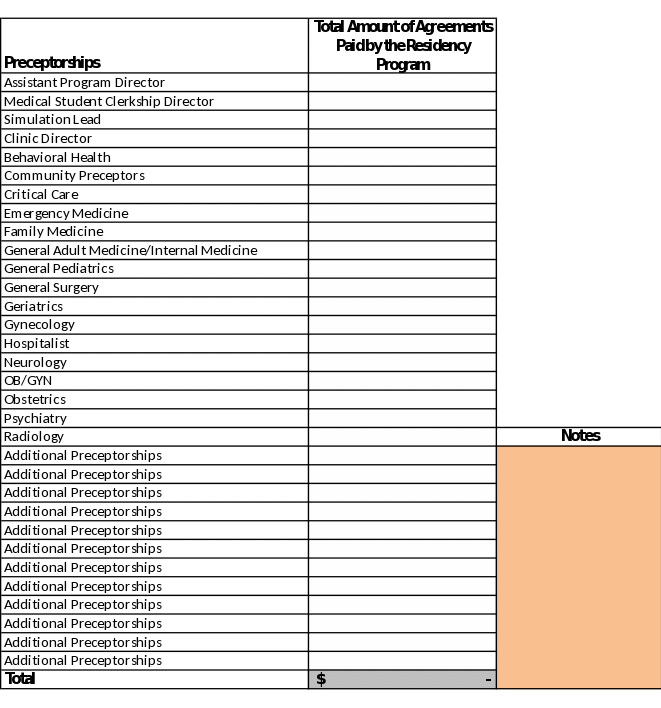 f
these fees are paid by the hospital rather than the residency
program, include expenses relative to Inpatient residency Training
on the Inpatient Revenue and Expense worksheet. Use the Notes
section included on that worksheet to indicate that the expense is
associated with contracted specialists who provide educational
experiences for THC residents.
f
these fees are paid by the hospital rather than the residency
program, include expenses relative to Inpatient residency Training
on the Inpatient Revenue and Expense worksheet. Use the Notes
section included on that worksheet to indicate that the expense is
associated with contracted specialists who provide educational
experiences for THC residents.
Resident Salaries and Benefits (Resid Salaries)
Page Guidance:
The purpose of this worksheet is to identify the expenses associated with residents’ salaries and benefits for the reporting academic period.
Most residents will be represented by one full (1.0) FTE. If a resident participates for less than the full reporting period, report the actual Total FTE for that resident.
Report salaries only for residents who are a part of an approved training program.
Use actual numbers for the academic year reported.
Report Actual Salary and Actual Benefits as well as the appropriate FTE amount corresponding to the specific Year of Residency. Report information for all residents in an approved program whose clinical services contribute to the Visits and Revenue worksheets.
Add rows for each PGY as necessary by double clicking a PGY cell, entering the respective PGY year and then the corresponding information.
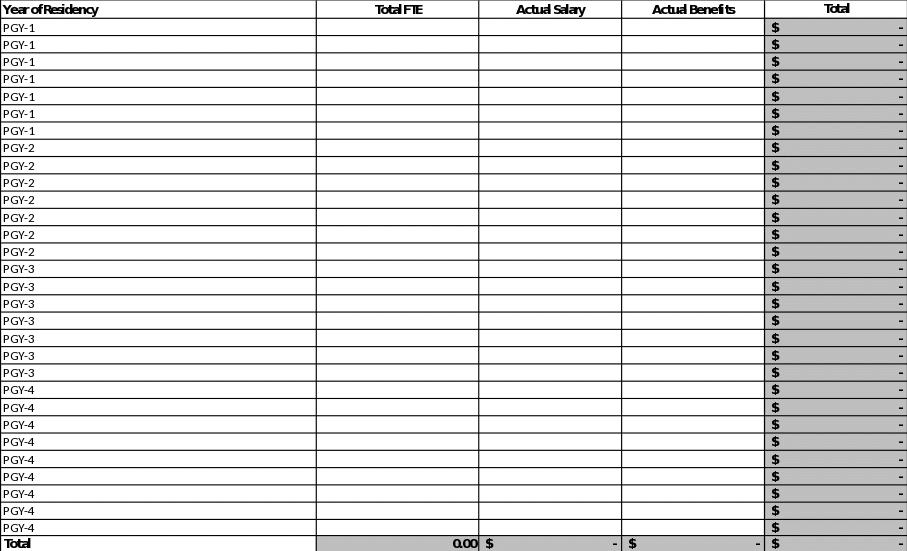
Residency Program Administrative Expenses and In-Kind Donations (Resid Admin)
Page Guidance
The purpose of this worksheet is to identify the full range of administrative expenses associated with educational and academic activities. Do not report expenses associated with administration in the continuity clinic(s) here. Report expenses associated with administration in the continuity clinic(s) on the Clinic Admin worksheet.
Report only those expenses directly attributed to the residency program. In cases where the residency program does not have an expense, enter "0".
Do not include expenses reported in other worksheets. For example, if you report insurance or licensing fees as an expense under the Clinic Ops worksheet, do not report them here.
Indicate the organization that provides in-kind donation expenses in the Notes section located to the right of the Residency Program Administrative Expenses Provided In-Kind to the THC column.
Residency Program Administrative Personnel
Under Residency Program Administrative Personnel paid by the THC, report expenses that are incurred by the residency program.
Under Residency Program Administrative Personnel Provided In-Kind to the THC, report the value of in-kind donations that go to the residency program.
When reporting Admin Support Salaries, identify the administrative personnel paid directly by the THC or provided in-kind to the THC.
When reporting Total FTE, include only time that is dedicated to the residency program during the reporting period.
Under Actual Salary and Actual Benefits, report the expenses paid by the THC or provided in-kind to the THC that are based on hours paid and actual costs incurred during the reporting period.

Residency Program Administrative Expenses
Report expenses that are incurred by the residency program expenses under Residency Program Administrative Expenses paid by the THC (left column).
Under Residency Program Administrative Expenses Provided In-Kind to the THC (right column), include the value of residency administrative costs that you do not have to pay because they are provided at no cost to the THC by another entity. For example, if your residency is housed for free in a location, estimate the amount you would have paid for the square footage had the residency been required to pay for the space it occupies.
Total Residency Square Footage
Enter the Total Residency Square Footage of the space allocated for the residency educational functions. Ensure that the square footage paid by the THC is in the left column, and the square footage provided in-kind to the THC is in the right column. Do not include clinical space on this worksheet.

Education/Didactic Costs
For Education/Didactic costs, report costs paid by the THC in the left column and donations provided in-kind to the THC in the right column.
For Resident Education Stipends, include any stipends for conferences, didactics, scholarly activity, and other reimbursements.
For Resident Required Training, include fees paid for any resident required licensures and programs, such as Advanced Cardiovascular Life Support certification, Pediatric Advanced Life Support certification, etc.
For Simulation Center Costs, include any costs associated with simulation center utilization. These may include fees to access simulation centers.
Include Education Supplies costs associated with library resources, textbooks, journal subscriptions, scholarly association fees, and software.
For Medical/Dental School or OPTI fees, report any fees associated with medical school, dental school or OPTI affiliations.
For General Educational Allowance, include the lump sum amount given to residents for their own purchase of educational supplies and materials.

Licensing and Certification Fees
For Licensing and Certification Fees, report fees paid by the THCs. If the resident pays the fees on their own, do not include those fees. Report costs paid by the THC in the left column and fees provided in-kind to the THC in the right column.
For Licensing Examination Fees, include any fees paid for resident licensing exams, such as USMLE/COMLEX fees.
For In-Service Examination Fees, report fees paid for resident in-service exams, such as ABP fees.
For Board Certification Fees, include any fees paid for residents for board certification exams or training.
When reporting Board Preparation Costs, include any software or similar costs for residents to prepare for the boards.
For Resident Licensing Fees, include any practice licensing fees paid for residents (this should not include faculty licensing fees, which should be included in the Clinic Ops worksheet).
For State Medical Licenses, report the costs of fees paid for residents.
Include costs for Resident Training Licenses for the residency program.
For DEA Licenses, report costs for DEA license registration fees.
Include costs for DATA-2000 Waivers that are paid for residents.
For Other Licensing Fees, include the name and amount of other costs that are not reported and are related to licensing and certification fees.

Program Fees and Costs
For Program Fees and Costs, report fees and costs paid by the THC in the left column and fees and costs provided in-kind to the THCs in the right column.
Include Accreditation Fees, such as per program annual assessments and per resident fees associated with ACGME accreditation.
For NRMP/Match Participation Fees, include any fees paid for participation in the NRMP or AOA match programs.
Report Recruitment Costs, such as candidate travel, give-a-ways, meals, brochures, etc.
Include Graduation Costs such as venue, food, entertainment, certificates, etc.
Include Faculty/Staff Development costs such as the National Institute for Program Director Development costs, honorarium, and staff development costs including conferences or association dues such as the Society of Teachers of Family Medicine dues.
Report Travel Costs such as educational courses and conferences, and any other travel that is paid for by the residency program, except Away Rotation Housing.
Include Away Rotation Housing costs, such as lodging costs for away rotations of the residents.
Include any General Liability Insurance purchased for the residency program.
Include Academic Malpractice Insurance only if specifically paid for residents or faculty related to residency program non-clinical activities.
Include all Legal and Accounting Fees associated with the residency program.
Include Consortium Expenses if your THC is part of a consortium, and these expenses do not appear in any other worksheet.
Report only Rent/Occupancy Fees specifically charged to the residency program for residency program space (e.g., faculty offices, coordinator office, resident space).

Supplies
For Supplies, report costs paid by the THC in the left column and costs provided in-kind to the THC in the right column.
For Mobile Communications Devices, include any pagers or cell phones purchased for residents or residency program staff. Also include the annual use charges paid by the residency program, if applicable.
Include costs for Laptops/Tablets, or other supplies that fall into this category for the residency program.
List costs for Telemedicine or Tele-education, or other costs that fall into this category for the residency program.
Include IT Costs that are only charged directly to the residency program, such as laptop computers, e-mail service, or residency program management software for residents.
Include White Coats/Uniforms for the residency program.
List any Printing and Postage expenses for the residency program.
List Office Supplies expenses for the residency program.

Other
For Other expenses, report expenses paid by the THC in the left column and expenses provided in-kind to the THC in the right column.
List any other expenses by name and amount not detailed above that are associated with the administration of the residency program. Also include the total for the academic year. Provide explanations in the Notes section.

Overhead
Report if your residency program has any administrative overhead costs and if so, how they are determined. Indicate in the Response section what your program includes in overhead costs. Report any central administrative overhead costs incurred by the residency program; however, do not account for administrative expenses in the continuity clinic(s) in this space as it will be reported in the Clinic Admin worksheet.

Clinic Administrative Expenses (Clinic Admin)
Page Guidance
For this worksheet, we will collect information on all administrative expenses attributable to the resident continuity clinic(s) and separated from all other costs related to the residency program. The definition of a continuity clinic aligns with ACGME requirements: a continuity clinic is a setting in which residents develop a continuous, long-term therapeutic relationship with a panel of patients, with the resident serving as the primary physician for this panel.
Include all clinic administrative costs that are not included as part of the Resid Admin worksheet or as part of overhead costs.
Enter expenses matched to the total medical or dental visits, revenue, and clinic operation expenses reported for the resident continuity clinic(s).
Do not include expenses reported in other worksheets. For example, do not report licensing fees reported in the Resid Admin worksheet.
Resident Continuity Clinic(s) Administrative Expenses
Include the expenses of the Administrative Personnel Salaries for the continuity clinic(s) for which you are reporting.
For Purchased Admin Services, include any contracts for administrative type services for the continuity clinic(s) only.
Report expenses for Office Supplies in the continuity clinic(s).
Include any additional Recruitment costs that are separate from the residency recruitment costs reported in the Resid Admin worksheet.
For Staff Development, include any non-residency, clinic staff development costs.
Include any Travel associated with clinical activities.
For IT Infrastructure, include any hardware, wiring, servers, or other items purchased during your reporting period.
Include Other Expense Types that are not duplicative and explain these expenses by name and amount in the Notes section.
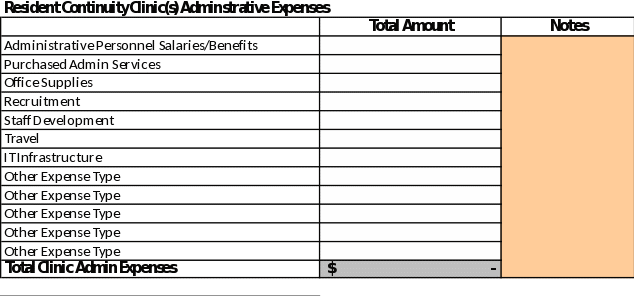
Overhead
Report any overhead costs here that were not reported elsewhere. Indicate what is included in these costs in the Notes section.
Include Administrative Overhead costs. This may include your organization's CEO, CFO, COO, CNO, CMO, etc. Your finance office would be the ones to have this information.
Report Finance and Accounting Overhead costs. This may include your organization's finance office, billing office, accounting fees, payroll office, etc.
Include any Physical Plant overhead costs such as maintenance, mortgage, repairs, etc. that are allocated as overhead to the continuity clinic(s).
Report IT overhead costs; this usually includes IT department staff.
For Other Expense Type, list the name and amount of any other overhead categories that are allocated to the continuity clinic(s) and explain these categories in the Notes section.

Clinical Operations Expenses (Clinic Ops)
Page Guidance
The purpose of this worksheet is to collect information on the total operational expenses of the continuity clinic(s) in relation to the continuity clinic(s) visits and revenue.
Enter expenses that are associated with the total precepted and non-precepted medical or dental visits, revenue, and clinic administration expenses reported for the continuity clinic(s).
Do not include expenses reported in other worksheets. For example, do not include licensing fees reported in the Resid Admin worksheet.
Clinic Square Footage
Insert the total Clinic square footage of the continuity clinic(s), NOT including any residency/educational space.

Clinic Operations Expenses
Enter Clinical Support Personnel Salaries/Benefits salaries not reported in the Clinic Admin or Resid Admin worksheets.
Report Purchased Medical/Dental Services expenses that are contracted clinical services and not accounted for in any other worksheets.
Report Medical/Dental Supplies expenses for patient care services in the continuity clinic(s).
Include Medical/Dental Equipment purchasing or maintenance expenses of that medical equipment.
Report Licensing Fees for the residents, faculty, providers, and staff working in the continuity clinic(s).
Report Malpractice Insurance expenses above and beyond FTCA coverage, if applicable. If the continuity clinic(s) are without FTCA coverage, please insert the malpractice costs for all insured at the clinic site(s), less any educationally related malpractice expense. Do not duplicate malpractice insurance expenses provided in the Resid Admin worksheet.
Include EHR Licenses/Maintenance expenses if the licenses are paid annually. If EHR licenses are a one-time fee that have been paid in a prior academic year, report maintenance costs only here.
Include costs of Uniforms such as white coats, scrubs, and staff uniforms.
Include Occupancy expenses such as rent, building maintenance, or utility costs that are not explicitly reported elsewhere.
Include Depreciation expenses for equipment or facility depreciation for any items not reported in the Medical/Dental Equipment line above.
For Other Expense Type, list the name and amount of any other expenses not listed in any other Clinic Operations Expenses lines and explain these categories in the Notes section.
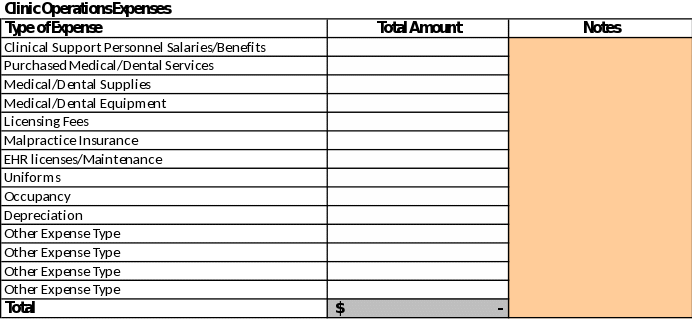
Inpatient Revenue and Expenses (IP Revenue and Expenses)
Page Guidance:
The purpose of this worksheet is to determine the costs incurred by a THC when its residents train in a hospital, and any associated payments made by the hospital back to the THC for inpatient care services performed by THC residents. Do not repeat information in this section that has been reported elsewhere in the THCGME Costing Instrument.
Inpatient Resident Service(s) Revenue
For Direct Payments, include professional fees and/or Part B revenue generated by faculty when supervising residents in the hospital that goes directly to the THC.
For Agreed Upon Payments, include hospital revenue associated with the resident inpatient service paid by the hospital to the THC (e.g., set amount per visit, per rotation, etc.).
For Medicare pass-through, report the amount of Medicare GME reimbursement that is allocated/passed through to the THC.
For State Medicaid, report the amount of applicable State Medicaid GME reimbursement or payments received by the hospital and allocated/passed through to the THC.
For Call and coverage, include any agreed upon amounts paid by the hospital to the THC for resident call and coverage at the hospital.
In the Other lines, describe name and amount of other forms of revenue not otherwise identified and explain these revenues in the Notes section.
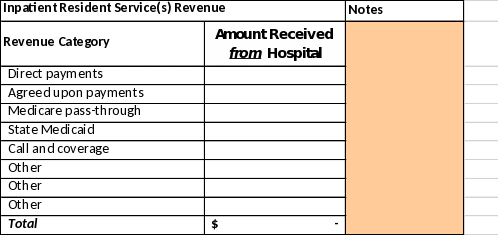
Inpatient Resident Service(s) Expenses
For Faculty costs, include costs for supervising faculty in the hospital. For example, report payments made by the THC to the hospital for faculty supervisory costs and faculty expenses not already reported on in other worksheets. Do not include faculty costs already identified elsewhere in the THCGME Costing Instrument (e.g., if a faculty member has hospital privileges and supervises the THC resident in the hospital).
For Staffing and support costs, report any direct staffing and support costs incurred by the hospital and passed on to the THC for payment (e.g., nursing, administrative staff, clinical extenders, etc.).
Report Facility costs imposed by the hospital for use of space to train, including patient care and didactic space.
For Indirect costs, report any amounts paid by the THC to the hospital to offset inefficiencies and/or other indirect costs.
Report Overhead expenses (exclusive of any facility and indirect costs above) allocated to the THC based on hospital-based rotations of THC residents.
Report In-kind expenses that are expenses absorbed by the hospital in support of the THC program, in lieu of an explicit payment. For example, include in-kind expenses such as dedicated space for residents provided by the hospital to support THC residency training.
For Other expenses, list the name and amount of any other expenses not listed in any other Inpatient Resident Service(s) lines and explain these categories in the Notes section.
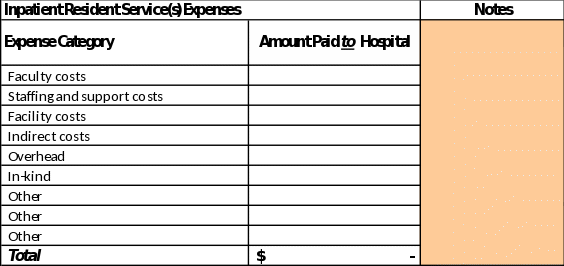
Additional Information About Your THC and Continuity Clinic(s) (Additional Info)
Page Guidance:
The purpose of this worksheet is to provide additional information about your continuity clinic(s) or health center that could affect THC financing, operations, and sustainability.
Include key points in the space provided that will be used to help us better understand your continuity clinic(s).
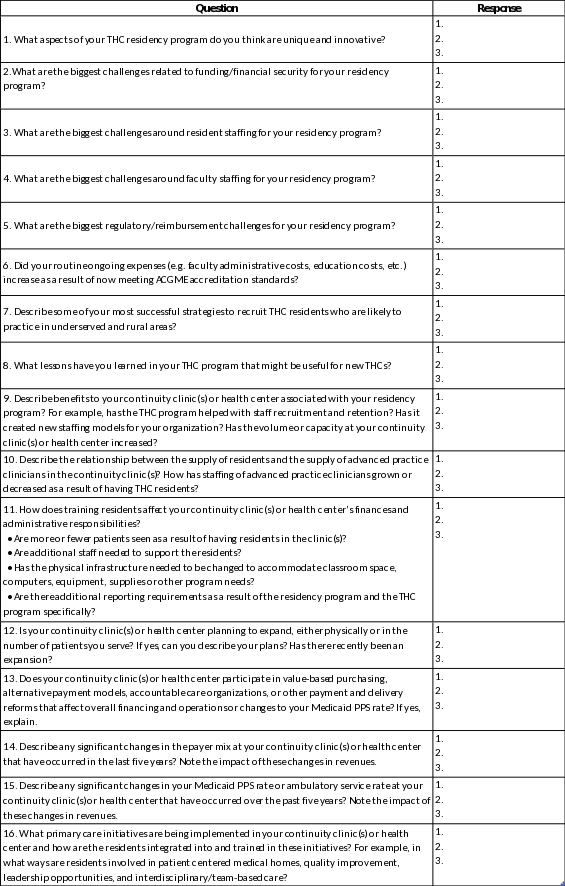


| File Type | application/vnd.openxmlformats-officedocument.wordprocessingml.document |
| File Title | THC Instruction Guide OMB |
| Author | Mariellen Jewers |
| File Modified | 0000-00-00 |
| File Created | 2021-01-13 |
© 2025 OMB.report | Privacy Policy
